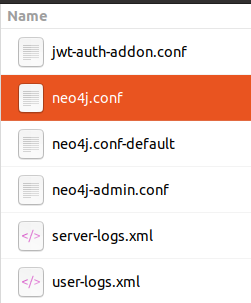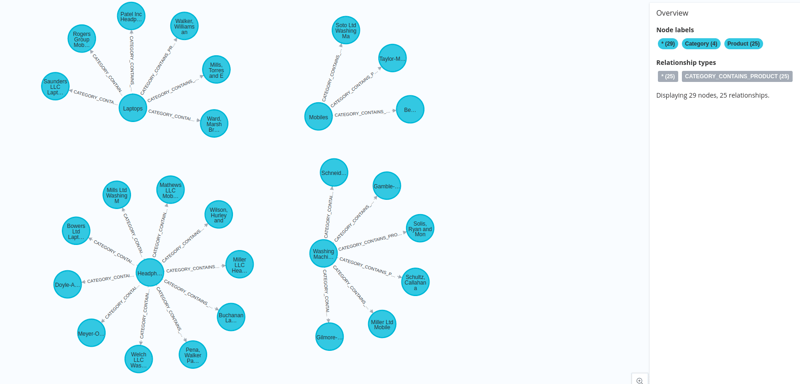Load Data Into Neo4j
In the previous blog we saw how to install and setup neo4j locally with 2 plugins APOC and Graph Data Science Library - GDS. In this blog I am going to take a toy dataset(products in a e-commerce website) and store that in Neo4j.
Allocating Sufficient Memory For Neo4j
Before starting to load the data if in your use case you have huge data ensure that sufficient amount of memory is allocated to neo4j. To do that :
- Click on the three dots to the right of open

- Click on Open folder -> Configuration

- Click on neo4j.conf

- Search for heap in neo4j.conf, uncomment lines 77, 78 and change 256m to 2048m, this ensures 2048mb is allocated for data storage in neo4j.

Creating Nodes
Graphs have two primary components nodes and relationships, let's create the nodes first and later establish the relationships.
The data I am using is present here - data
Use the requirements.txt present here to create a python virtual environment - requirements.txt
Let's define various functions to push data.
Importing necessary libraries
import pandas as pd from neo4j import GraphDatabase from openai import OpenAI
- We are going to use openai to generate embeddings
client = OpenAI(api_key="")
product_data_df = pd.read_csv('../data/product_data.csv')
- To generate embeddings
def get_embedding(text):
"""
Used to generate embeddings using OpenAI embeddings model
:param text: str - text that needs to be converted to embeddings
:return: embedding
"""
model = "text-embedding-3-small"
text = text.replace("\n", " ")
return client.embeddings.create(input=[text], model=model).data[0].embedding
- As per our dataset we can have two unique node labels, Category : Category of product, Product: Name of product. Let's create category label, neo4j offers something called property, you can imagine these to be metadata for a particular node. Here name and embedding are the properties. So we are storing the name of category and its corresponding embedding in DB.
def create_category(product_data_df):
"""
Used to generate queries for creating category nodes in neo4j
:param product_data_df: pandas dataframe - data
:return: query_list: list - list containing all create node queries for category
"""
cat_query = """CREATE (a:Category {name: '%s', embedding: %s})"""
distinct_category = product_data_df['Category'].unique()
query_list = []
for category in distinct_category:
embedding = get_embedding(category)
query_list.append(cat_query % (category, embedding))
return query_list
- Similarly we can create product nodes, here the properties would be name, description, price, warranty_period, available_stock, review_rating, product_release_date, embedding
def create_product(product_data_df):
"""
Used to generate queries for creating product nodes in neo4j
:param product_data_df: pandas dataframe - data
:return: query_list: list - list containing all create node queries for product
"""
product_query = """CREATE (a:Product {name: '%s', description: '%s', price: %d, warranty_period: %d,
available_stock: %d, review_rating: %f, product_release_date: date('%s'), embedding: %s})"""
query_list = []
for idx, row in product_data_df.iterrows():
embedding = get_embedding(row['Product Name'] + " - " + row['Description'])
query_list.append(product_query % (row['Product Name'], row['Description'], int(row['Price (INR)']),
int(row['Warranty Period (Years)']), int(row['Stock']),
float(row['Review Rating']), str(row['Product Release Date']), embedding))
return query_list
- Now let's create another function to execute the queries generated by the above 2 functions. Update your username and password appropriately.
def execute_bulk_query(query_list):
"""
Executes queries is a list one by one
:param query_list: list - list of cypher queries
:return: None
"""
url = "bolt://localhost:7687"
auth = ("neo4j", "neo4j@123")
with GraphDatabase.driver(url, auth=auth) as driver:
with driver.session() as session:
for query in query_list:
try:
session.run(query)
except Exception as error:
print(f"Error in executing query - {query}, Error - {error}")
- Complete code
import pandas as pd
from neo4j import GraphDatabase
from openai import OpenAI
client = OpenAI(api_key="")
product_data_df = pd.read_csv('../data/product_data.csv')
def preprocessing(df, columns_to_replace):
"""
Used to preprocess certain column in dataframe
:param df: pandas dataframe - data
:param columns_to_replace: list - column name list
:return: df: pandas dataframe - processed data
"""
df[columns_to_replace] = df[columns_to_replace].apply(lambda col: col.str.replace("'s", "s"))
df[columns_to_replace] = df[columns_to_replace].apply(lambda col: col.str.replace("'", ""))
return df
def get_embedding(text):
"""
Used to generate embeddings using OpenAI embeddings model
:param text: str - text that needs to be converted to embeddings
:return: embedding
"""
model = "text-embedding-3-small"
text = text.replace("\n", " ")
return client.embeddings.create(input=[text], model=model).data[0].embedding
def create_category(product_data_df):
"""
Used to generate queries for creating category nodes in neo4j
:param product_data_df: pandas dataframe - data
:return: query_list: list - list containing all create node queries for category
"""
cat_query = """CREATE (a:Category {name: '%s', embedding: %s})"""
distinct_category = product_data_df['Category'].unique()
query_list = []
for category in distinct_category:
embedding = get_embedding(category)
query_list.append(cat_query % (category, embedding))
return query_list
def create_product(product_data_df):
"""
Used to generate queries for creating product nodes in neo4j
:param product_data_df: pandas dataframe - data
:return: query_list: list - list containing all create node queries for product
"""
product_query = """CREATE (a:Product {name: '%s', description: '%s', price: %d, warranty_period: %d,
available_stock: %d, review_rating: %f, product_release_date: date('%s'), embedding: %s})"""
query_list = []
for idx, row in product_data_df.iterrows():
embedding = get_embedding(row['Product Name'] + " - " + row['Description'])
query_list.append(product_query % (row['Product Name'], row['Description'], int(row['Price (INR)']),
int(row['Warranty Period (Years)']), int(row['Stock']),
float(row['Review Rating']), str(row['Product Release Date']), embedding))
return query_list
def execute_bulk_query(query_list):
"""
Executes queries is a list one by one
:param query_list: list - list of cypher queries
:return: None
"""
url = "bolt://localhost:7687"
auth = ("neo4j", "neo4j@123")
with GraphDatabase.driver(url, auth=auth) as driver:
with driver.session() as session:
for query in query_list:
try:
session.run(query)
except Exception as error:
print(f"Error in executing query - {query}, Error - {error}")
# PREPROCESSING
product_data_df = preprocessing(product_data_df, ['Product Name', 'Description'])
# CREATE CATEGORY
query_list = create_category(product_data_df)
execute_bulk_query(query_list)
# CREATE PRODUCT
query_list = create_product(product_data_df)
execute_bulk_query(query_list)
Creating Relationships
- We are going to create relationships between Category and Product and the name of the relationship would be CATEGORY_CONTAINS_PRODUCT
from neo4j import GraphDatabase
import pandas as pd
product_data_df = pd.read_csv('../data/product_data.csv')
def preprocessing(df, columns_to_replace):
"""
Used to preprocess certain column in dataframe
:param df: pandas dataframe - data
:param columns_to_replace: list - column name list
:return: df: pandas dataframe - processed data
"""
df[columns_to_replace] = df[columns_to_replace].apply(lambda col: col.str.replace("'s", "s"))
df[columns_to_replace] = df[columns_to_replace].apply(lambda col: col.str.replace("'", ""))
return df
def create_category_food_relationship_query(product_data_df):
"""
Used to create relationship between category and products
:param product_data_df: dataframe - data
:return: query_list: list - cypher queries
"""
query = """MATCH (c:Category {name: '%s'}), (p:Product {name: '%s'}) CREATE (c)-[:CATEGORY_CONTAINS_PRODUCT]->(p)"""
query_list = []
for idx, row in product_data_df.iterrows():
query_list.append(query % (row['Category'], row['Product Name']))
return query_list
def execute_bulk_query(query_list):
"""
Executes queries is a list one by one
:param query_list: list - list of cypher queries
:return: None
"""
url = "bolt://localhost:7687"
auth = ("neo4j", "neo4j@123")
with GraphDatabase.driver(url, auth=auth) as driver:
with driver.session() as session:
for query in query_list:
try:
session.run(query)
except Exception as error:
print(f"Error in executing query - {query}, Error - {error}")
# PREPROCESSING
product_data_df = preprocessing(product_data_df, ['Product Name', 'Description'])
# CATEGORY - FOOD RELATIONSHIP
query_list = create_category_food_relationship_query(product_data_df)
execute_bulk_query(query_list)
- By using MATCH query to match the already created nodes we establish relationships between then.
Visualizing The Created Nodes
Hover over the open icon and click on neo4j browser to visualize the nodes that we have created.



And our data is loaded into neo4j along with their embeddings.
In the fore-coming blogs we'll see how to build a graph query engine using python and use the fetched data to do augmented generation.
Hope this helps... See you !!!
LinkedIn - https://www.linkedin.com/in/praveenr2998/
Github - https://github.com/praveenr2998/Creating-Lightweight-RAG-Systems-With-Graphs/tree/main/push_data_to_db
The above is the detailed content of Load Data Into Neo4j. For more information, please follow other related articles on the PHP Chinese website!

Hot AI Tools

Undresser.AI Undress
AI-powered app for creating realistic nude photos

AI Clothes Remover
Online AI tool for removing clothes from photos.

Undress AI Tool
Undress images for free

Clothoff.io
AI clothes remover

Video Face Swap
Swap faces in any video effortlessly with our completely free AI face swap tool!

Hot Article

Hot Tools

Notepad++7.3.1
Easy-to-use and free code editor

SublimeText3 Chinese version
Chinese version, very easy to use

Zend Studio 13.0.1
Powerful PHP integrated development environment

Dreamweaver CS6
Visual web development tools

SublimeText3 Mac version
God-level code editing software (SublimeText3)

Hot Topics
 1664
1664
 14
14
 1421
1421
 52
52
 1315
1315
 25
25
 1266
1266
 29
29
 1239
1239
 24
24
 Python vs. C : Applications and Use Cases Compared
Apr 12, 2025 am 12:01 AM
Python vs. C : Applications and Use Cases Compared
Apr 12, 2025 am 12:01 AM
Python is suitable for data science, web development and automation tasks, while C is suitable for system programming, game development and embedded systems. Python is known for its simplicity and powerful ecosystem, while C is known for its high performance and underlying control capabilities.
 The 2-Hour Python Plan: A Realistic Approach
Apr 11, 2025 am 12:04 AM
The 2-Hour Python Plan: A Realistic Approach
Apr 11, 2025 am 12:04 AM
You can learn basic programming concepts and skills of Python within 2 hours. 1. Learn variables and data types, 2. Master control flow (conditional statements and loops), 3. Understand the definition and use of functions, 4. Quickly get started with Python programming through simple examples and code snippets.
 Python: Games, GUIs, and More
Apr 13, 2025 am 12:14 AM
Python: Games, GUIs, and More
Apr 13, 2025 am 12:14 AM
Python excels in gaming and GUI development. 1) Game development uses Pygame, providing drawing, audio and other functions, which are suitable for creating 2D games. 2) GUI development can choose Tkinter or PyQt. Tkinter is simple and easy to use, PyQt has rich functions and is suitable for professional development.
 Python vs. C : Learning Curves and Ease of Use
Apr 19, 2025 am 12:20 AM
Python vs. C : Learning Curves and Ease of Use
Apr 19, 2025 am 12:20 AM
Python is easier to learn and use, while C is more powerful but complex. 1. Python syntax is concise and suitable for beginners. Dynamic typing and automatic memory management make it easy to use, but may cause runtime errors. 2.C provides low-level control and advanced features, suitable for high-performance applications, but has a high learning threshold and requires manual memory and type safety management.
 How Much Python Can You Learn in 2 Hours?
Apr 09, 2025 pm 04:33 PM
How Much Python Can You Learn in 2 Hours?
Apr 09, 2025 pm 04:33 PM
You can learn the basics of Python within two hours. 1. Learn variables and data types, 2. Master control structures such as if statements and loops, 3. Understand the definition and use of functions. These will help you start writing simple Python programs.
 Python and Time: Making the Most of Your Study Time
Apr 14, 2025 am 12:02 AM
Python and Time: Making the Most of Your Study Time
Apr 14, 2025 am 12:02 AM
To maximize the efficiency of learning Python in a limited time, you can use Python's datetime, time, and schedule modules. 1. The datetime module is used to record and plan learning time. 2. The time module helps to set study and rest time. 3. The schedule module automatically arranges weekly learning tasks.
 Python: Exploring Its Primary Applications
Apr 10, 2025 am 09:41 AM
Python: Exploring Its Primary Applications
Apr 10, 2025 am 09:41 AM
Python is widely used in the fields of web development, data science, machine learning, automation and scripting. 1) In web development, Django and Flask frameworks simplify the development process. 2) In the fields of data science and machine learning, NumPy, Pandas, Scikit-learn and TensorFlow libraries provide strong support. 3) In terms of automation and scripting, Python is suitable for tasks such as automated testing and system management.
 Python: Automation, Scripting, and Task Management
Apr 16, 2025 am 12:14 AM
Python: Automation, Scripting, and Task Management
Apr 16, 2025 am 12:14 AM
Python excels in automation, scripting, and task management. 1) Automation: File backup is realized through standard libraries such as os and shutil. 2) Script writing: Use the psutil library to monitor system resources. 3) Task management: Use the schedule library to schedule tasks. Python's ease of use and rich library support makes it the preferred tool in these areas.




